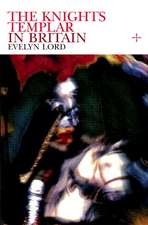Illustrated Religious Texts in the North of Europe, 1500-1800
Autor Feike Dietz Editat de Els Stronks Autor Adam Morton, Lien Roggenen Limba Engleză Hardback – 6 aug 2014
| Toate formatele și edițiile | Preț | Express |
|---|---|---|
| Paperback (1) | 262.14 lei 6-8 săpt. | |
| Taylor & Francis – 14 oct 2024 | 262.14 lei 6-8 săpt. | |
| Hardback (1) | 1005.34 lei 6-8 săpt. | |
| Taylor & Francis – 6 aug 2014 | 1005.34 lei 6-8 săpt. |
Preț: 1005.34 lei
Preț vechi: 1226.03 lei
-18% Nou
Puncte Express: 1508
Preț estimativ în valută:
192.40€ • 200.12$ • 158.83£
192.40€ • 200.12$ • 158.83£
Carte tipărită la comandă
Livrare economică 12-26 aprilie
Preluare comenzi: 021 569.72.76
Specificații
ISBN-13: 9781409467519
ISBN-10: 1409467511
Pagini: 300
Dimensiuni: 156 x 234 x 18 mm
Greutate: 0.6 kg
Ediția:1
Editura: Taylor & Francis
Colecția Routledge
Locul publicării:Oxford, United Kingdom
ISBN-10: 1409467511
Pagini: 300
Dimensiuni: 156 x 234 x 18 mm
Greutate: 0.6 kg
Ediția:1
Editura: Taylor & Francis
Colecția Routledge
Locul publicării:Oxford, United Kingdom
Cuprins
Contents: Introduction: the function and nature of international religious contacts in Northern Europe, Els Stronks, Adam Morton and Feike Dietz. Part I Crosscurrents in Ideologies and Motives: Idols in the frontispiece? Illustrating religious books in the age of iconoclasm, Alexandra Walsham; Catechisms: teaching the eye to read the world, Lee Palmer Wandel; Religious plurality in Karel van Mander’s The Nativity Broadcast by Prophets of the Incarnation of 1588, Walter S. Melion; The diaspora of a Jesuit press: mimetic imitation on the world stage, Mia M. Mochizuki; A product of confession of corruption? The Common Weales Canker Wormes (ca.1625) and the progress of sin in early modern England, Adam Morton. Part II Forms of Exchange and Mobility: Godly visions and idolatrous sights: images of divine revelation in early English Bibles, David J. Davis; Recycling and reforming origins: the double creation in Claes Jansz. Visscher’s Theatrum Biblicum (1643), Amanda K. Herrin; An author’s wishes versus a publisher’s possibilities: the illustration of Thomas Sailly’s prayer books printed by the Plantin Press in Antwerp c.1600, Dirk Imhof; No home grown products: illustrated biblical poems in the Dutch republic, Els Stronks; Linking the Dutch market to its German counterpart: the case of Johannes Boekholt and a newly discovered 1661 edition of Levendige herts-theologie, Feike Dietz; Singing together and seeing differently: confessional boundaries in the illustrated hymnal, Erin Lambert. Index nominum.
Notă biografică
Feike Dietz is Assistant Professor in Early Modern Dutch Literature and Culture at Utrecht University. Her PhD project focused on the interconfessional exchange of illustrated religious literature in the Dutch Republic. This topic has been the focus of several articles and her book Literaire levensaders. Internationale uitwisseling van woord, beeld en religie in de Republiek (Literary Lifelines. The International Exchange of Word, Image and Religion in the Dutch Republic). Adam Morton is a Post-Doctoral Fellow at the University of Oxford. He previously worked at the Universities of Warwick and York. He researches anti-Catholicism and visual culture in Reformation England, and has published several articles as well as a volume on post-Reformation confessional identities, Getting Along? Religious Identities and Confessional Relations in Early Modern England (Ashgate, 2011). He is currently transforming his PhD thesis into a monograph. Lien Roggen studied Germanic Languages at the Catholic University of Leuven and is currently finishing her PhD on the emblematic oeuvre of the Flemish Jesuit Adriaan Poirters (1605-1674). Lien’s research focuses especially on Poirters’ appropriating of prints from a Latin context and his constant rewriting of his own work in which the relation between text and image changes in order to meet his Dutch readership. Els Stronks is Professor of Early Modern Dutch Literature and Culture at Utrecht University. She previously taught at Indiana University. She is the author of several articles and books. Her recent monograph, Negotiating Differences: Word, Image and Religion in the Dutch Republic, discusses how the first centuries of illustrated religious literature in the Northern Netherlands reveal patterns of social behaviour and confessional identity formation. Marc Van Vaeck is Professor of Early Modern Dutch Literature at the Catholic University of Leuven. He is the author of numerous articles on religious emblematics, and co-edi
Descriere
Illustrated Religious Texts in the North of Europe, 1500-1800 provides a new perspective on the role of visual imagery in the Reformation period by focusing on international forms of collaboration, and makes a significant contribution to ongoing debates concerning the history of the book by focusing on the ideological as well as practical side of international contacts.














